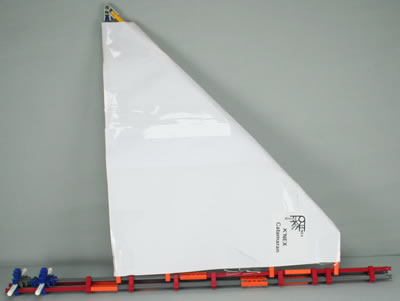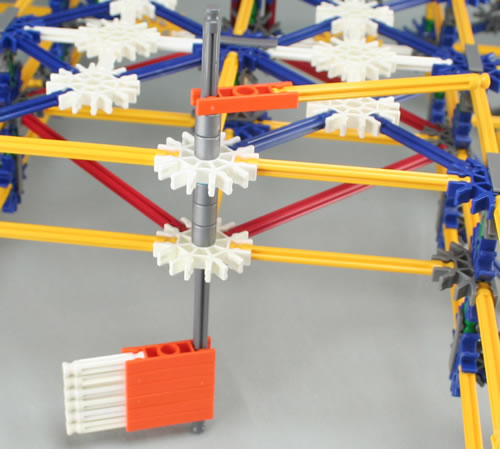
K'NEX Catamaran
This K'NEX Catamaran really sails!
View video
It is 54cm (21 inches) long, and can be built using:
1. A K'NEX Base kit
2. An extra 8 yellow rods.
3. An extra 30 grey 3D connectors.
4. Some plastic sheet (eg carrier bags)
5. Some string

First, assemble the seventy 3D connectors shown in the photo opposite.
Please visit Handy Hint A4 if you need help to do this.

…cover it with thin plastic sheet or paper, and secure with sticky tape.
Make sure that in applying the sticky tape you do not prevent the sail from swinging around the mast.

Make the rudder by adding to a red rod:
1. An orange connector end-on.
2. A yellow rod on the end of the orange connector.
3. Two silver spacers.
4. A white connector.
5. A blue spacer.
6. Three silver spacers.
7. A white connector.
8. Six orange connectors end-on, each with a white rod attached.

To secure the sail:
1. Tie a length of string to the lower white connector on the rudder.
2. Pass the string through the light grey connector at the lower corner of the sail.
3. Pass the string through the upper white connector on the rudder.
4. Attach the string to the yellow rod on the right with a purple clip, as shown, and cut off any surplus string.
The length of the string can then be shortened or lengthened as required when sailing the catamaran, by twisting the yellow rod so that the string wraps around it.

…and attach it to the top of the rudder as shown.
This pushes the rudder down below the water level, and it also makes it slightly harder to turn the rudder, so that the rudder stays in the position in which it has been set.

Finally, carefully wrap plastic sheet around each of the hulls, as shown, securing it with sticky tape.
Your catamaran is now complete.
What next?
To test your catamaran:
1. Take it to an outdoor pool on a day when a light breeze is blowing
2. Place the catamaran in the water, with the wind behind it.
3. Set the rudder straight ahead.
4. Lengthen or shorten the string, so that the sail is at the angle you require.
5. Check that it sails OK, and that water does not leak into the hulls.
6. Experiment with different settings for the rudder, and a variety of sail positions on each side of the catamaran.
























